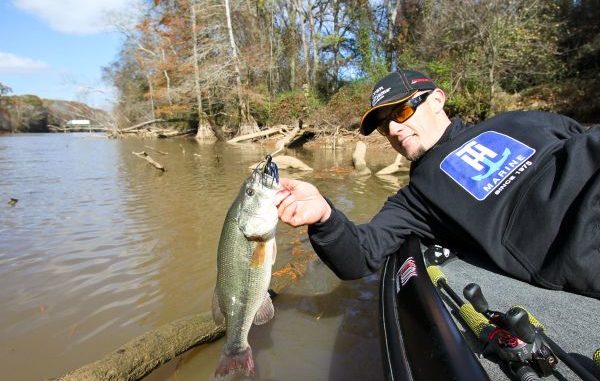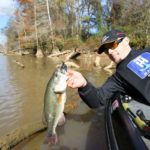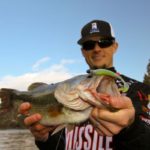
Most folks think baitcasting gear is too heavy for finesse applications. But downsizing your reel and rod action can open up new bass-fishing worlds.
Power-fishing, chucking-and-winding, the grind — we typically think of baitcasters for such duties, while the more modest, finesse presentations usually go hand-in-hand with spinning tackle.
There’s no problem with either thought, but consider a melding of the two. Picture a small, subtle presentation with the accuracy and casting efficiency of a revolving spool reel.
This, in the proverbial nutshell, is the essence of light baitcasters.
In some cases, it’s a manufacturer’s concerted efforts to minimize a reel’s weight by thinning frames or cutting away unnecessary bulk, as is the case with Quantum’s Exo reels.
Other times, anglers might simply opt for modest-sized reels with lighter line.
In any case, learning to work with baitcasting gear for the more finessey techniques that usually involve spinning gear can prove rewarding.
FLW pro Andrew Upshaw likes Lew’s Tournament Lite reel for its combination of light weight (5.8 ounces), a hardy drag system and its ability to cast light baits well.
Upshaw pairs that reel with a Lew’s Custom Speed Stick, matching the action to the technique at hand.
“One technique that comes to mind that is an absolute favorite of mine is fishing a super-light Texas rig on 10- to 12-pound-test fluorocarbon,” he said. “I’ll use the Tournament Lite or Team Lew’s Lite and the Custom Speed Stick Soft Plastics Rod.
“I use a 1/16- to 1/8-ounce unpegged Elite Tungsten bullet weight, a Gene Larew TattleTail Worm and a 3/0 to 4/0 Mustad Grip Pin Finesse Hook. I use this technique all through the fall and during the post-spawn for bass around grass or stumps.”
That lightweight rig entices bites by allowing the worm to slowly swim on the fall, he said.
If fish don’t bite on the fall, he’ll use a lift/swim/fall technique.
“This is the process of swimming the worm through the grass and never really letting it hit the bottom,” Upshaw explained. “The fish in the fall and post-spawn have a tendency to sit a little higher in the grass than at other times of the year, so keeping the worm high will get you a lot of bites.”
Upshaw said he’ll also use a light baitcasting system for a wacky rig, fishing a TattleTail with a 1/32-ounce nail weight and a 1/0 Mustad DropShot hook attached to an O-ring slid over the worm.
“This is a great way to catch fish anywhere you go,” Upshaw said. “No matter if it’s docks, around timber, grass, bluegill beds or spawning bass — fish always eat a wacky worm.”
There are some specifics to how he rigs it out, though.
“I hook the worm right below the egg sack through the O-ring, with the hook point toward the tail. I also put a nail in the head,” Upshaw said. “Sometimes I might even put a small rattle in the tail portion, especially if the water has some color to it.”
Louisiana guide Darold Gleason arms himself with a Quantum Tour MG 6.3:1 reel on a Falcon Lowrider Cranker rod when he ties on moving baits.
“When I use a light baitcaster, it’s for (smaller) crankbaits such as a flat-sided balsa or a small swimbait,” Gleason said. “This is a good strategy on lakes that fish tough in the late summer or fall.
“I use this technique when I need to throw a small bait but prefer a baitcaster over spinning: The baitcaster allows me to make smooth casts with the lighter baits.”
FLW pro T-Roy Broussard, who also is a cast member of Swamp People, turns to a Lew’s Tournament Pro reel on a Castaway Skeleton weightless worm rod to sling different finesse rigs on 10-pound Sunline Sniper fluorocarbon with pinpoint accuracy.
“I use baitcasters occasionally for dropshotting or throwing a wacky rig, but most often I use a light baitcast application for throwing a small finesse worm Texas-rigged with a 2/0 EWG light hook with a 1/16- to 1/8-ounce tungsten weight,” Broussard said.
Preferring such tactics in highly pressured areas and post-frontal conditions, Broussard noted that while a dropshot isn’t practical for specific targets such as shallow wood or rock, the wacky and Texas rigs are better choices.
The latter, he said, allows him optimal castability and precision.
“It’s a definite confidence bait for me,” Broussard said of Texas rigs. “A Strike King KVD finesse worm in green pumpkin or watermelon/red on a 2/0 Trokar EWG hook is my go-to bait.”
But some conditions call for a change-up.
“If water is cold or stained, I will use a Strike King Ocho (stick worm),” Broussard explained. “I usually bite the Ocho in half and use the tail end on the hook.
“I will thread the Ocho on the hook starting with the tail end to give it a different action (and a smaller profile).”
Pickwick Lake guide Jimmy Mason values when throwing weightless baits like the YUM Dinger or Houdini Shad.
Mason also appreciates the sensitivity of a light baitcasting outfit for flipping finesse jigs like the Booyah Boo Bug or Baby Boo.
Toledo Bend guide Stephen Johnston pointed out that your light baitcasting outfits can even facilitate a finesse version of a popular full-sized baitcasting technique — dock skipping.
Firing a smaller worm with little or no extra weight under a dock might be a tough job with standard baitcasting gear, while spinning tackle offers less accuracy.
Often skipping, wacky rigging and shaky-heading with 6- to 12-pound line, Johnston said light baitcasters can help you sneak a small bait into a tight area — but he pointed out that you can’t expect the best of both worlds, in terms of fish-fighting beefiness.
“I think the biggest deal with a light reel is that you just don’t have that big drag system you have in a regular reel,” he said.





